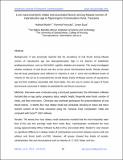Low macronutrients intake and associated factors among Maasai women of reproductive age in Ngorongoro Conservation Area, Tanzania

View/
Date
2014Author
Martin, Haikael
Petrucka, Pammla
Buza, Joram
Metadata
Show full item recordAbstract
Background: It was previously reported that the prevalence of oral thrush among Maasai women of reproductive age was disproportionately high in the absence of established predisposing factors, such as HIV/AIDS, syphilis, diabetes and anaemia. This study investigated whether incidence of oral thrush was due to low serum micronutrients levels. Results showed that all study participants were deficient in Vitamins A and C; some had insufficient levels of Vitamin D. We set out to understand the normal dietary intake of Maasai women of reproductive age and their traditions associated with food intake. Our aim was to review the types of foods and amounts consumed in relation to potentials for oral thrush occurrence.
Methods: Interviews were conducted using a structured questionnaire; the information collected included data on age, parity, pregnancy status, weight, height, frequently eaten foods, number of meals, and food restrictions. Clinicians also examined participants for presence/absence of oral thrush lesions. A twenty four hour dietary recall was conducted, focusing on macro and micro nutrient content of the food consumed using the Tanzania Food Composition Table and computed with Excel™ 2007 software.
Results: The twenty four hour dietary recall assessment revealed that the most frequently eaten food (71%) was thin porridge made from maize flour. Carbohydrates contributed the most energy (approximately 80%), followed by fats (12%), and protein (8%). Student’s t-test showed no significant difference in dietary intake of carbohydrates and protein between women with and without oral thrush (with p>0.05). However, all groups showed low intake of protein, carbohydrates, fats and micronutrients such as vitamins A, C, B12, folate, and iron.
Conclusions: There is a need of intervening in this community through nutrition education and advocacy among health workers who are expected to spread the knowledge to the community. These findings are important in addressing the type of food aid directed to this community, which should include protein sources like beans.
